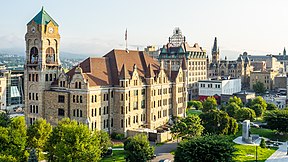Scranton | |
|---|---|
Downtown Scranton Courthouse Square | |
| Nicknames: The Electric City, The All America City, Steamtown | |
| Motto(s): Embracing Our People, Our Traditions and Our Future | |
| Anthem: "Hail, Pennsylvania!" | |
 Interactive map of Scranton | |
| Coordinates: 41°24′38″N 75°40′03″W / 41.41056°N 75.66750°W | |
| Country | |
| State | |
| County | Lackawanna |
| Region | Greater Scranton |
| Incorporated (borough) | February 14, 1856 |
| Incorporated (city) | April 23, 1866 |
| Named for | George W. Scranton |
| Government | |
| • Type | Mayor-Council |
| • Body | Scranton City Council |
| • Mayor | Paige Cognetti (D) |
| Area | |
• City | 25.54 sq mi (66.14 km2) |
| • Land | 25.31 sq mi (65.55 km2) |
| • Water | 0.23 sq mi (0.60 km2) |
| • Metro | 1,777 sq mi (4,602 km2) |
| Elevation | 745 ft (227 m) |
| Population | |
• City | 76,328 |
| • Density | 3,015.96/sq mi (1,164.49/km2) |
| • Urban | 366,713 (US: 113th) |
| • Urban density | 2,261.4/sq mi (873.1/km2) |
| • Metro | 567,559 (US: 100th) |
| Demonym | Scrantonian/Scrantonite |
| Time zone | UTC−05:00 (EST) |
| • Summer (DST) | UTC−04:00 (EDT) |
| ZIP Codes | 18447, 18501–18505, 18507–18510, 18512, 18514–18515, 18517–18519, 18522, 18540, 18577 |
| Area code(s) | 570 and 272 |
| FIPS code | 42-69000 |
| GNIS feature ID | 634293[3] |
| Website | www |
Scranton is a city in and the county seat of Lackawanna County, Pennsylvania, United States. With a population of 76,328 as of the 2020 U.S. census,[4] Scranton is the most populous city in Northeastern Pennsylvania and the Wyoming Valley metropolitan area, which has a population of 562,037 as of 2020. It is the sixth-most populous city in Pennsylvania.[5]
The contiguous network of five cities and more than 40 boroughs all built in a straight line in Northeastern Pennsylvania's urban core act culturally and logistically as one continuous city, so while Scranton is a mid-sized city, the larger Scranton/Wilkes-Barre metropolitan area contains half a million residents in roughly 300 square miles (780 km2). Scranton is the cultural and economic center of Northeastern Pennsylvania, a region of the state with over 1.3 million residents.
Scranton hosts a federal court building for the United States District Court for the Middle District of Pennsylvania. The city is conventionally divided into nine districts: North Scranton, Southside, Westside, Eastside/Hill Section, Central City, Minooka, West Mountain, East Mountain, and Green Ridge, though these areas do not have legal status. The city is the geographic and cultural center of the Lackawanna River valley and Northeastern Pennsylvania, as well as the largest of the former anthracite coal mining communities in a contiguous quilt-work that also includes Wilkes-Barre, Nanticoke, Pittston, and Carbondale.
Scranton was incorporated on February 14, 1856, as a borough in Luzerne County and as a city on April 23, 1866. It became a major industrial city and a center of mining and railroads; it attracted thousands of new immigrants. It was the site of the Scranton general strike in 1877. The city was designated as the county seat when Lackawanna County was established in 1878, and a judicial district was authorized in July 1879.
The city's nickname "Electric City" began when electric lights were introduced in 1880 at the Dickson Manufacturing Company. Six years later, the United States' first streetcars powered only by electricity began operating in the city.[6][7] Rev. David Spencer, a local Baptist minister, later proclaimed Scranton as the "Electric City".[8]
The city's industrial production and population peaked during the 1930s and 1940s, caused by demand for coal and textiles, especially during World War II. But while the national economy boomed after the war, demand for the region's coal declined as other forms of energy became more popular, which also harmed the rail industry. Foreseeing the decline, city leaders formulated the Scranton Plan in 1945 to diversify the local economy beyond coal, but the city's economy continued to decline. The Knox Mine disaster of 1959 essentially ended coal mining in the region. Scranton's population dropped by over 67,000, from its peak of 143,433 in the 1930 census, to 76,089 in the 2010 census, but had rebounded slightly by 2020. The city now has large health care, academic, tourism, railroad, and manufacturing sectors.
Scranton is located 56 miles (90 km) north of Allentown, 104 miles (167 km) north-northwest of Philadelphia, and 99 miles (159 km) west-northwest of New York City.
- ^ "ArcGIS REST Services Directory". United States Census Bureau. Retrieved October 12, 2022.
- ^ Cite error: The named reference
USCensusDecennial2020CenPopScriptOnlywas invoked but never defined (see the help page). - ^ U.S. Geological Survey Geographic Names Information System: Scranton, Pennsylvania
- ^ Cite error: The named reference
QF2020was invoked but never defined (see the help page). - ^ "Scranton, Wilkes, Barre Metro Area". Usa.com. Archived from the original on January 2, 2016. Retrieved October 26, 2015.
- ^ "First Electric Cars Historical Marker". explorepahistory.com. Archived from the original on November 27, 2018. Retrieved November 27, 2018.
- ^ "Pennsylvania Historical Marker Search". www.phmc.state.pa.us. Archived from the original on March 29, 2018. Retrieved November 27, 2018.
- ^ Kashuba, Cheryl A (August 22, 2010). "Scranton gained fame as the Electric City, thanks to the region's innovative spirit". Scranton Times-Tribune. Archived from the original on April 14, 2015. Retrieved April 14, 2015.








